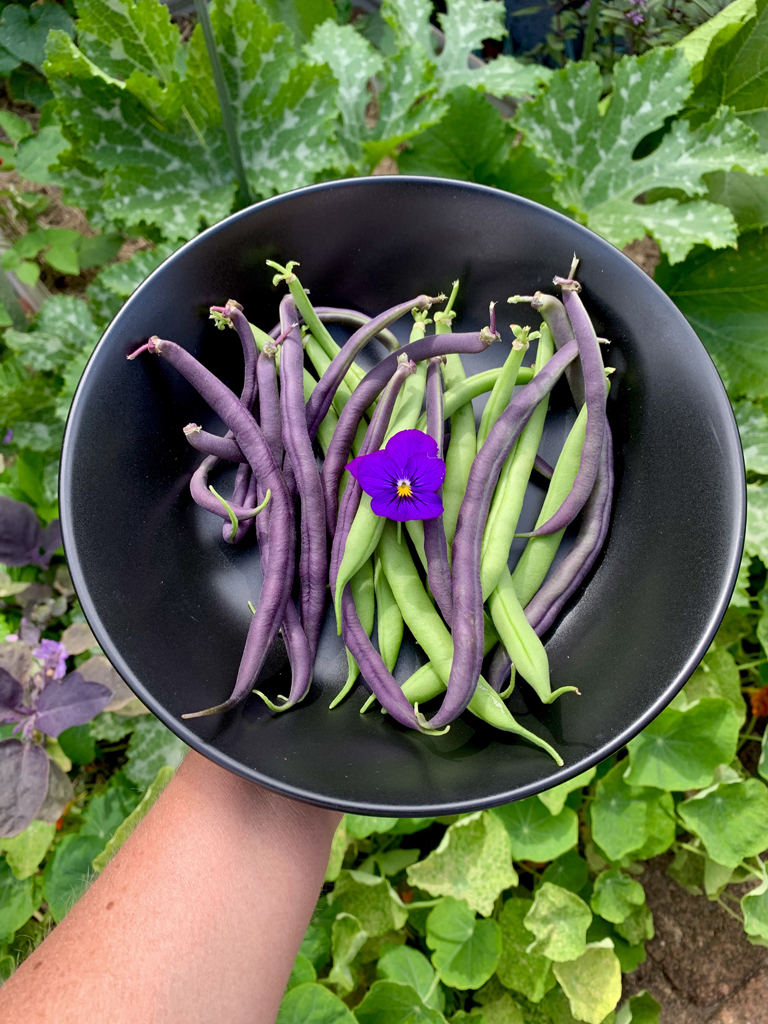Bush Beans are an easy crop to grow when you’re short on space. Here are my tips on how to grow bush beans for a continual summer harvest.

Bush Beans – Photo © The Gourmantic Garden
Summer in the garden is often synonymous with tomatoes and basil but there’s another crop that’s well worth growing with a great return on investment.
In my tiny courtyard garden, I can’t afford to give space to crops that take up too much room and don’t deliver the goods. Bush beans are one of my favourite summer crops to grow. They start producing early in spring and continue until late summer. I grow my bush beans in repurposed recycling crates.
My favourite beans to grow are as follows:
- Provider Bush Beans (green)
- Cherokee Wax Butter Beans (yellow)
- Royal Burgundy Beans (purple)
- Rattlesnake Beans (mottled appearance)

Rattlesnake Bean Tepee – Photo © The Gourmantic Garden
Rattlesnake Beans are not bush beans but I was able to grow them successfully in a repurposed recycling crate by building a tepee using bamboo sticks.
I start by prepping the soil by topping it up and adding compost, blood and bone and a little chicken manure pellets a couple of weeks before transplanting or direct sowing. Here are my top tips for how to grow bush beans for a continual summer harvest.
Tips for How to Grow Bush Beans for a Continual Summer Harvest

Bush Beans – Photo © The Gourmantic Garden
- Soak the beans overnight in water then sow 20mm deep.
- Sow the first round of seeds in mid-August (Sydney temperate climate). Beans can be direct sown or raised as seedlings. I’ve used both methods and I find raising seedlings gives me more control over the exact position of what gets planted where. Also, some seeds may not germinate.
- Once the first round of beans shows signs of flowering, sow the next round of seeds. This is usually around the 6 week mark. As the weather gets hotter, they will germinate and grow much faster.
- Water well and regularly. As I’m growing in containers, on the days with no rain, I water daily and deeply.
- Harvest beans regularly by snipping the fruit with garden shears or secateurs. Don’t pull on them as you may accidentally dislodge the delicate flowers. The more you harvest, the more the plant puts its energy into flowering and fruiting.
- Remove any scorched or pest damaged leaves regularly by snipping them at the junction with the stem. My garden is open on three sides and gets the hot sun all day which means at some point, the leaves get scorched and dry. You could also cover with a shade cloth on very hot days.
- After the first flush of beans, the plant slows down a little. Trim any diseased/dry leaves and top dress the soil with a little blood and bone and water it in well. Unless the plant is badly scorched, you will soon get another round of beans.
- By succession planting as well as maintaining the routine of harvesting fruit regularly, removing damaged leaves and applying blood and bone between fruiting, I was able to get an abundance of bush beans throughout the summer season.

Beans – Photo © The Gourmantic Garden
Before the end of summer, leave a few healthy beans to dry on the plant so you can save seeds for planting the following year. Choose large and plump beans such as these.
At the end of summer, production slows down and you may get bean rust which is a mottled rusty appearance on the fruit. They’re not edible at this stage and while you could apply an eco spray, the plant is signalling the end of its life and it’s time to thank it and bid it farewell.

Bean Rust – Photo © The Gourmantic Garden
By applying succession planting and a regular maintenance, you can have an abundance of delicious beans in a small garden that you can eat fresh or freeze and enjoy during the cooler months.

